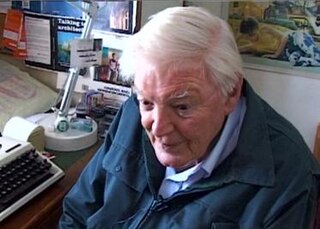Freedom is a London-based anarchist website and biannual journal published by Freedom Press which was formerly either a monthly, a fortnightly or a weekly newspaper.

Freedom Press is an anarchist publishing house and bookseller in Whitechapel, London, United Kingdom, founded in 1886.

Colin Ward was a British anarchist writer and editor. He has been called "one of the greatest anarchist thinkers of the past half century, and a pioneering social historian."
Clifford Harper is a worker, illustrator, and militant anarchist. He wrote Anarchy: A Graphic Guide in 1987. He is a long-term contributor to The Guardian newspaper and many other publications.

The Green Anarchist, established in 1984 in the UK, was a magazine advocating green anarchism.

Anarchy in Action is a book exploring anarchist thought and practice, written by Colin Ward and first published in 1973.

Albert Isidore Meltzer was an English anarcho-communist activist and writer.

Anarchism in the United Kingdom initially developed within the religious dissent movement that began after the Protestant Reformation. Anarchism was first seen among the radical republican elements of the English Civil War and following the Stuart Restoration grew within the fringes of radical Whiggery. The Whig politician Edmund Burke was the first to expound anarchist ideas, which developed as a tendency that influenced the political philosophy of William Godwin, who became the first modern proponent of anarchism with the release of his 1793 book Enquiry Concerning Political Justice.

Anarchism has long had an association with the arts, particularly with visual art, music and literature. This can be dated back to the start of anarchism as a named political concept, and the writings of Pierre-Joseph Proudhon on the French realist painter Gustave Courbet. In an essay on Courbet of 1857 Proudhon had set out a principle for art, which he saw in the work of Courbet, that it should show the real lives of the working classes and the injustices working people face at the hands of the bourgeoisie.
In the United States, anarchism began in the mid-19th century and started to grow in influence as it entered the American labor movements, growing an anarcho-communist current as well as gaining notoriety for violent propaganda of the deed and campaigning for diverse social reforms in the early 20th century. By around the start of the 20th century, the heyday of individualist anarchism had passed and anarcho-communism and other social anarchist currents emerged as the dominant anarchist tendency.
David Goodway is a British historian and a respected international authority on Chartism and on anarchism and libertarian socialism.

The Cause of Labor was a libertarian communist magazine published by exiled Russian and Ukrainian anarchists. Initially under the editorship of Peter Arshinov, after it published the Organizational Platform, the subsequent controversy resulted in his exit from the anarchist movement. The magazine was then picked up by Grigorii Maksimov, who moved it to the United States and edited it until his death in 1950.
Road to Freedom was a monthly anarchist political journal published by Hippolyte Havel. The journal is known as the successor to Emma Goldman's Mother Earth.
George Molnar (1934–1999) was a Hungarian-born philosopher whose principal area of interest was metaphysics. He worked mainly in the Philosophy Department at the University of Sydney but resided in England from 1976 to 1982. He published four philosophical papers in two separate spells; the first two in the 1960s and the second two after a return to the profession in the 1990s. His book Powers: A Study in Metaphysics was published posthumously in 2003.
The following outline is provided as an overview of and topical guide to anarchism:
Anarchism: A Documentary History of Libertarian Ideas is a three-volume anthology of anarchist writings edited by historian Robert Graham. The anthology is published by Black Rose Books. Each selection is introduced by Graham, placing each author and selection in their historical and ideological context. The focus of the anthology is on the origins and development of anarchist ideas; it is not a documentary history of the world's anarchist movements, although the selections are geographically diverse.

Henry Albert Seymour was an English secularist, individualist anarchist, gramophone innovator and survey author, and Baconian. He published the first English language anarchist periodical in Britain and is credited, in 1913, with introducing the Edison disc into the country.
Wildcat was a monthly anarchist-libertarian newspaper published from London between 1974 and 1975. Wildcat is not connected to the communist newsletter and journal of the same name published in the 1980s and 1990s.
Rufus Segar was a British anarchist, illustrator, and graphic designer best known for his designs of Anarchy magazine throughout the 1960s.









